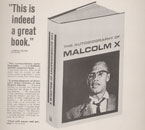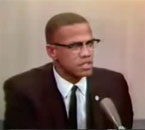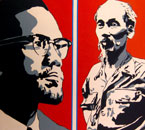Although the political leader central to the rise of the black power movement—Malcolm X—was a strong champion of cultural self-determination, he was not beyond using “any means necessary,” including the mainstream media, to achieve his goals.
The national spokesman for the Nation of Islam, the Black Muslim religious group, Malcolm X was a fierce opponent of Martin Luther King, Jr., and his advocacy of civil disobedience, integration, and interracial dialogue. When persecuted by racial oppression, Malcolm X argued, black Americans must not see themselves as victims, but fight aggressively, meeting brutality with violence if necessary, to maintain their freedom and independence.
Malcolm X was one of the most media-savvy black leaders of the period, readily employing television, magazines, and newspapers to spread the ideology of Islam and black nationalism. By the time of his assassination, in February 1965, he had appeared on scores of television programs, arguably more than any other civil rights figure including King. This media outreach helped build membership in the Nation of Islam from five hundred in 1952 to 30,000 in 1963, and enabled its leaders to influence African American public opinion for decades to come.
Image Credits/Captions (Click on thumbnails for full image)
The Autobiography of Malcolm X (Grove Press) 1966. 11 x 8 in. Collection of Civil Rights Archive/CADVC-UMBC, Baltimore, MD, Anonymous Gift, 2009.13
TV Still: WMAQ-TV. City Desk, March 17, 1963. Courtesy of NBC News Archives. Malcolm X mastered television, crafting every aspect of on-air persona—from his elegant dark suits and ties to his urbane speaking style—to emphasize his physical attractiveness, intelligence, and rhetorical gifts. He spoke forcefully and insistently, refusing to stop until he delivered the exact and complete message he wished to convey. Rarely raising his voice or demonstrating any sign of anger or agitation, the charismatic leader remained coolly in charge of rhetoric designed to convince African Americans of the justness and urgency of his cause.
Robert Flora. Malcolm X, Los Angeles, 28 May 1963. Gelatin silver print. 6 3/8 x 9 5/8 in. UPI Telephoto HCP052804-5/28/63. Courtesy United Press International and estate of Robert Flora. A keen steward of his own and the Nation of Islam’s visual representation in the media, Malcolm X often carried a camera to record Black Muslim activities, and even set up the shots of photojournalists assigned to cover the group.
MALCOLM X born: May 19, 1925/HO CHI MINH born: May 19, 1890, n. d. Silkscreen on paper. 17 1/2 x 22 1/2 in. Collection of Civil Rights Archive/CADVC-UMBC, Baltimore, MD, 2005.196



